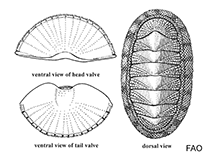Chiton tuberculatus Linnaeus, 1758
West Indian green chitonWarning: DOMDocument::load(): SSL operation failed with code 1. OpenSSL Error messages: error:140770FC:SSL routines:SSL23_GET_SERVER_HELLO:unknown protocol in C:\Apache24\htdocs\includes\SpeciesSummary.lib.php on line 1236
Warning: DOMDocument::load(): Failed to enable crypto in C:\Apache24\htdocs\includes\SpeciesSummary.lib.php on line 1236
Warning: DOMDocument::load(https://sealifebase.nrm.se/webservice/AquaMaps/getAMap.php?genus=Chiton&species=tuberculatus): failed to open stream: operation failed in C:\Apache24\htdocs\includes\SpeciesSummary.lib.php on line 1236
Warning: DOMDocument::load(): I/O warning : failed to load external entity "https://sealifebase.nrm.se/webservice/AquaMaps/getAMap.php?genus=Chiton&species=tuberculatus" in C:\Apache24\htdocs\includes\SpeciesSummary.lib.php on line 1236
Mandar um arquivo com seu (sua) Fotos
Imagem do Google | No image available for this species;
drawing shows typical species in Chitonidae.
Imagem do Google | No image available for this species;
drawing shows typical species in Chitonidae.
Classification / Names Common names | Synonyms | CoL | ITIS | WoRMS
| Chitonida | Chitonidae
Environment: milieu / climate zone / depth range / distribution range Ecologia
; intervalo de profundidade 0 - 4 m (Ref. 2022). Tropical
Distribuição Países | Áreas FAO | Ecossistemas | Ocorrências | Introduções
Western Central Atlantic: USA, Colombia, Bermuda, Mexico, Venezuela and the West Indies.
Length at first maturity / Tamanho / Peso / Idade
Maturity: Lm ? range ? - ? cm Max length : 7.6 cm TL macho/indeterminado; (Ref. 281)
Descrição suscinta Morfologia
Valve color: Dull grayish green or greenish brown; Some valves, dark-brown arrow-shaped patch on the dorsal ridge. Lateral areas: Five irregular, radiating cords. Central areas: Smooth at the top and eight to nine strong, wavy, longitudinal ribs on the sides. Girdle color: Alternating zones of whitish, green or black. Scales: Appear to be slightly higher than broad (Ref. 281).
Epibiotic (Ref. 110502). Very common under rocks, in the zone between tides (Ref. 292); intertidal to shallow subtidal (Ref. 289); intertidal and spray zones of rocky shores (Ref. 2022).
Life cycle and mating behavior Maturidade | Reprodução | Desova | Ovos | Fecundidade | Larvas
Members of the class Polyplacophora are mostly gonochoric. Life cycle: Eggs hatch into lecitotrophic planktonic trocophore larvae (no veliger stage) which later metamorphose and settle on the bottom as young adults.
Referência principal
Referências | Coordenador | Colaboradores
Burghardt, G. and L. Burghardt. 2006. (Ref. 281)
Status na Lista Vermelha da IUCN (Ref. 130435)
Status no CITES (Ref. 108899)
Not Evaluated
CMS (Ref. 116361)
Not Evaluated
Perigo para os humanos
Uso pelos humanos
| FishSource |
Ferramentas
Mais informação
Fontes da internet
BHL | BOLD Systems | CISTI | DiscoverLife | FAO(Publication : search) | Fishipedia | GenBank (genoma, nucleotídeo) | GloBI | Gomexsi | Google Books | Google Scholar | Google | PubMed | Árvore da vida | Wikipedia (Ir para, procura) | Registro zoológico
Estimates based on models
Preferred temperature
(Ref. 115969): 25.8 - 28.3, mean 27.5 (based on 436 cells).
Categoria de preço
(Ref. 80766):
Unknown.



